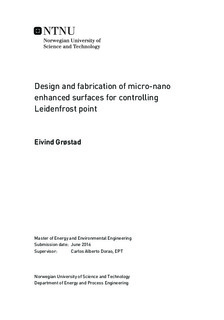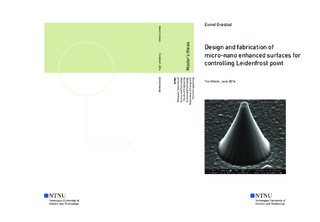| dc.description.abstract | The technological revolution has driven the need for faster microprocessors. In order to fabricate faster microprocessors the trend has been to increase the amount of transistors and increase the clock speed. Microprocessor clock speed reached a point of saturation in 2006 because of the thermal challenges related to the transistors. As microprocessor power densities are increasing beyond air cooling limits, liquid cooling will become necessary. Spray cooling turn out to be the best candidate.
Spray cooling have shown the ability to remove large amounts of energy due to latent heat of evaporation in addition to single-phase convection effects at low operational temperatures. A fundamental drawback with spray cooling is the limit of operation temperature due to the Leidenfrost effect, a vapour cushion forming in between the liquid and the solid and hence a spontaneous reduction in heat transfer. It is therefore essential to understand how to control at which temperature the Leidenfrost effect occur. Engineered micro-nano structures have shown the capability to manipulate the Leidenfrost point.
The main objective in this work is to identify and fabricate structures for enhancing the Leidenfrost point. The secondary objective is to design and fabricate a test facility for studying impacting droplet over a micro-nano structure surface.
In this work optimal structures for enhancing the Leidenfrost point have been identified from the literature. Techniques for fabricating the selected structures have been carried out and the structures have been characterized by available equipment at the NTNU Nanolab. Micro pillars, micro cones, Carbon nanowires and a hierarchical combination of small and big scale structures of the same type have been developed. In addition, a hierarchical combination of Carbon nanowires and micro cones. Furthermore, design and fabrication of a test section for studying impacting droplets over a micro-nano structure surface has been completed.
Important results uncovered in this work are the following. Helium flow rate has been identified as an essential tool for post fabrication analysis of the etching process and the height limit of the cone fabrication has been revealed. Anomalous wetting characteristics has been identified for a sample with hierarchical structures consisting of two cones of different scale.
This work has shown that lithography and deep reactive ion etching have the ability to fabricate surfaces with controllable structures to enhance the characteristics of the surface. Such structures will help to improve the understanding of how surface structures can enhance the Leidenfrost point. Spray cooling as a possible candidate for liquid cooling of microprocessors and other devices with high heat flux and restrictions on operational temperature is strengthened. | |

